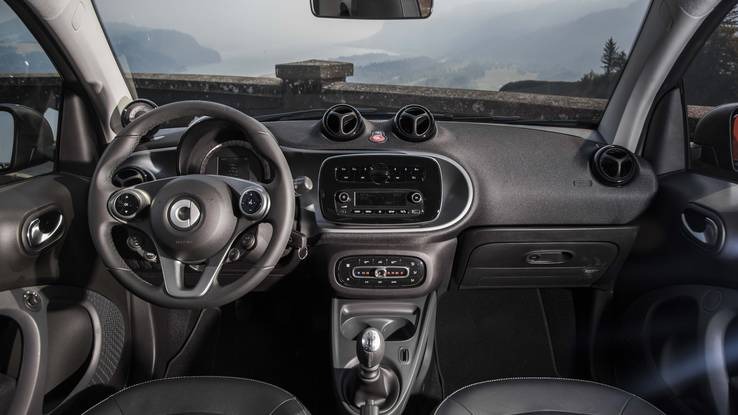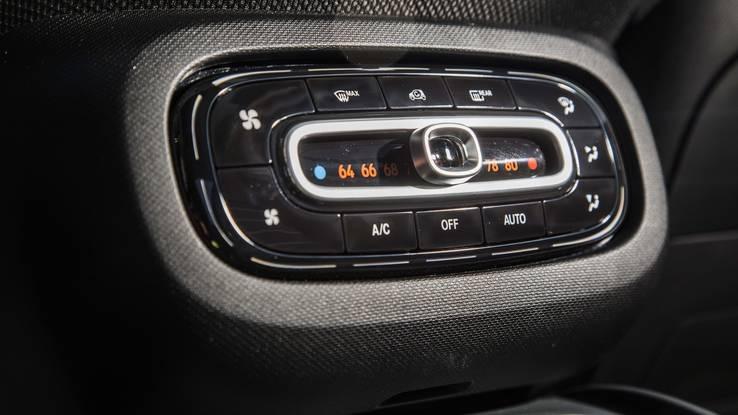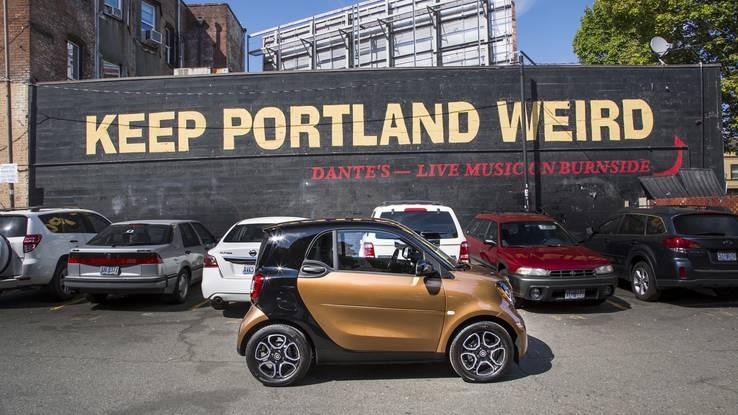After a thorough rewrite, the Smart story reads better but has the same ending
What is it? It’s the second generation of that weird roller-skate-looking thing your hippie-turned-middle-manager neighbor bought to help change the world. The original Smart was an experiment that continues to perform relatively well in Europe but never quite appealed to American tastes.
One reason for the original ForTwo’s rarity in the U.S. is that it never seemed all that smart: The car was expensive for what it offered, and fuel economy mediocre for the sacrifices required. Unfortunately, the new car continues in this tradition with a base price of $ 15,400 and 36 mpg combined. For comparison, an extra grand will buy both the front AND back halves of a car in the form of, say, a Honda Fit, which gets the same combined fuel economy but can carry two more people AND 4 cubic feet of more stuff (or the same number of people and more than four times the cargo: 12.2 cubic feet in the Smart vs. 52.7 cubic feet in the Fit with rear seats folded).

Roomy and upright, the Smart ForTwo’s passenger compartment is fine even for longer journeys, but this is basically the WHOLE CAR.
That math is why parent company Daimler (nee Mercedes) plays up the Fortwo as a premium city car, touting its minimal turning circle and ease of parking. If those are your key criteria, you’ll be impressed: The new Fortwo comes in at 8.8 feet long, exactly the same as the previous model, allowing it to shoehorn itself into miniscule parking spaces. Aiding that pursuit is a 22.8 foot turning circle, meaning the little coupe can just about pivot on its rear tire, giving you Ken Block-style car-control superpowers on narrow city streets.
In case you get overconfident and perform one of those miracle U-turns into oncoming traffic, Smart also maintains the previous model’s impressive Tridion safety cell construction. The system uses high-strength multiphase steel to form a protective shell around the occupant, and both government and Mercedes’ internal crash testing shows the structure performs surprisingly well.
Pushing everything along in the ForTwo is an 898cc turbocharged three-cylinder making 89 hp and 100 lb-ft of torque, coupled to either a five-speed manual transmission (yes, even in the U.S.) or a six-speed dual-clutch automatic. The power unit sits under the cargo area of the car and drives the rear wheels.
Four trim levels are available, all with cute names that begin with “P”: Pure, Passion, Prime and Proxy. Even the base Pure ForTwo comes with power steering, Crosswind Assist, Bluetooth, power windows, cruise control and automatic climate control. That last item uses a cool slider that magnifies the temperature as it moves across the dial like something out of an old transistor radio. Infotainment options include a smartphone app called Cross Connect that can help Smart owners identify unique parking spaces and access navigation, route and vehicle information.

The mid-century magnifying design of the automatic climate control slider is your author’s favorite Smart design element.
What’s it like to drive?
Assuming you, your passenger and all your stuff fit, the new ForTwo is a surprisingly entertaining driver. Smart exorcised the single-clutch manumatic from the old version and replaced it with a proper dual-clutch unit; there’s some of the same grabbiness at launch found on nearly all DCTs, but otherwise it fires off quick, satisfying shifts and makes the most of the robust three-cylinder turbo engine.
Despite its diminutive size, the Smart ForTwo legitimately earns some of its “premium” cred by being a relaxed, quiet freeway cruiser. The car has no trouble keeping up with expressway traffic and even has reserve power for passing, while tire and road noise are kept relatively at bay. Thanks to its high seating position and tall greenhouse, from behind the wheel the Smart feels less like a microcar and more like a compact crossover — at least until you look in the rearview mirror and realize you’re driving one-third of a compact crossover. Speaking of mirrors, you’ll be using them a lot -– the huge B/C pillar makes visual checks of your blind spot impossible.
The real fun is the low-speed handling, particularly in the Smart’s natural environment: congested city streets. Whipping the car through narrow gaps in traffic and performing almost single-lane U-turns, you begin to understand the car’s purpose in life. Slot the ForTwo into a motorcycle-size parking space and you almost … almost … forget (or at least stop caring) that you’re driving a high-top sneaker with wheels.

Mission: Accomplished.
Do I want it?
Probably not, but it’s not all the Smart ForTwo’s fault. Along with America’s frustratingly persistent “bigger-is-better” mentality, we also have wide (if crumbling) boulevards and, for the most part, decent parking in all but our most congested cities. The fundamental fact is that the Smart car only makes sense in a few U.S. locations, and even in those its mediocre fuel economy, lack of usable space, questionable value and goofy looks result in a tough sell.
Regardless, there will always be those who eschew the herd mentality and want to zip around the city in a convenient, premium hardtop scooter; Smart execs figure there are enough of them to justify the effort of selling the ForTwo in America, and with the improvements in the new car plus a sub-$ 20K price nicely equipped, we think they’re probably right.




























